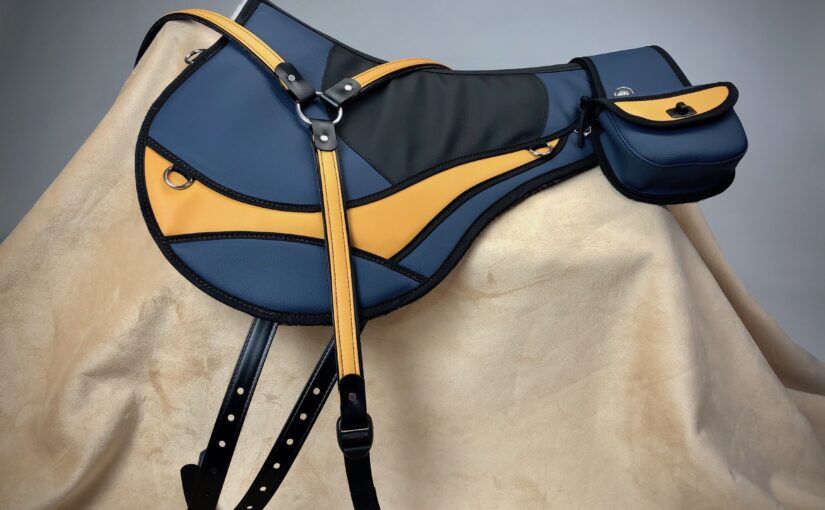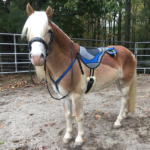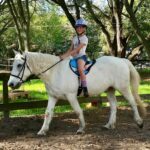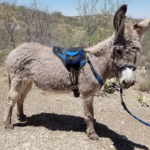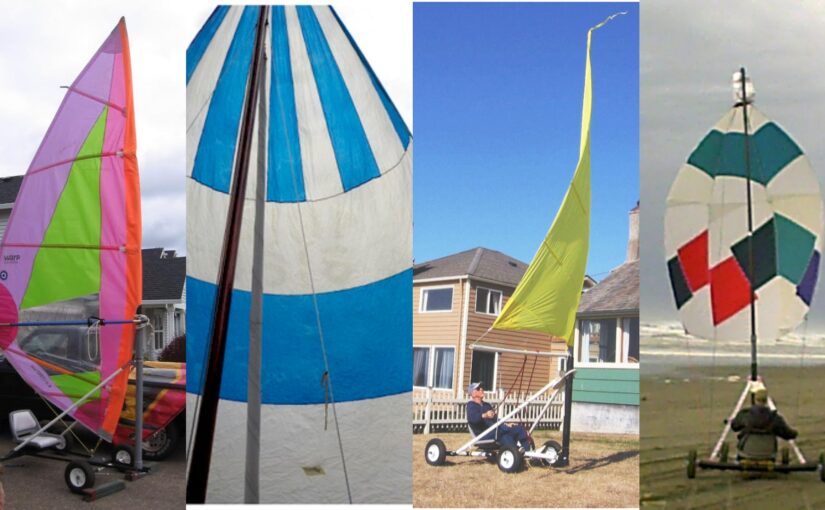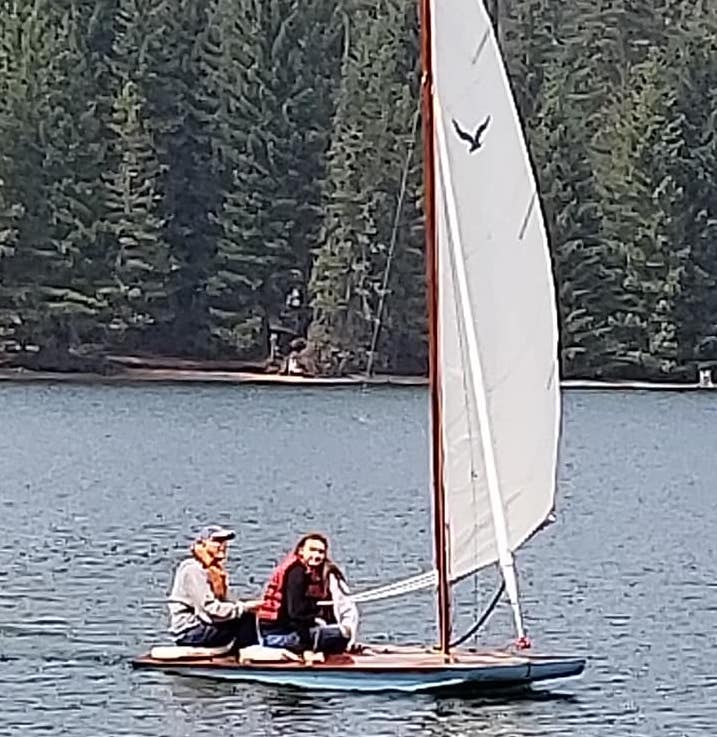With passion, patience and persistence, anything is possible. When it comes to the world of DIY sewing projects, this statement still rings just as true. Sailrite® customer Jessica Roush has blended her impressive sewing skills with her love of horses to create something special. With her industrial Sailrite® Fabricator® Sewing Machine in tow, Jessica has started her own small business selling custom bareback pads for avid horseback riders like herself. And she was kind enough to share her inspiring story with us!
As any animal lover knows, the fascination with furry friends begins early on. Jessica’s interest in horses began at age 4 when she begged her parents for a four-legged friend. It was around this same time that her fascination with sewing began, and the two hobbies would develop side by side in the years to come. At age 5, Jessica received a toy sewing machine for Christmas that sewed with glue instead of a needle and thread. But she wished for a pony and a real sewing machine every year.
At 11, she finally got one of her wishes: her very own pony! “His name was Tony and he was so good for me. I was able to escape life while I was with him, pretending to be a cowboy or an Indian while riding him. I soon became tired of saddling him up and learned to ride bareback [without a saddle].”

But riding a horse for hours without a saddle creates a lot of sweat on both the legs of the rider and on the parts of the horse’s back that are in direct contact with them. To remedy this, a bareback pad is often needed. This pad secures to the horse in a similar way as a saddle but is made of lightweight material (regular saddles can be quite heavy). These pads don’t always have stirrups, which are not necessary to ride a horse bareback.
Jessica began riding bareback so often that she was given a bareback pad for Christmas one year. “It did not take long for me to get super frustrated with the bareback pad moving back, so much so that it got the point that I was not sitting on it properly. The rigging was in the wrong location and there was no wither relief.” For those readers who aren’t equestrians, the withers on a horse are the highest part of a horse’s back, located at the base of the neck between the shoulder blades. If a saddle or bareback pad does not fit properly on this part of the horse, it can cause soreness for both horse and rider.
It was also around this time that Jessica started sewing for a home economics class, for which she had an immediate talent. Her teacher was so impressed with her skills that she asked Jessica to hem all of her class curtains, which Jessica did with great joy. This was only the beginning of her foray into sewing.
After high school, Jessica moved to Indiana and got a job at a factory sewing boat cushions and other boating necessities. Later, she moved on to sewing at several sewing shops, working on anything from canvas toppers for boats to bedspreads for RV factories. She moved once again to Sandpoint, Idaho, where she found a job sewing for a company that made everything from saddle pads to Kevlar® bulletproof vests.

Even during that busy time, her passion for horses was never extinguished. “Over the next 40 years, I owned horses. For most of those, I rode bareback, still not finding a well-designed bareback pad. When I did find a good bareback pad, the price was way out of my range starting at $350! I barely had two nickels to rub together and no money to spend on such a luxury.”
So Jessica did what any crafty DIYer would — she began to work on her own bareback pads! “My first supplies were purchased at a local store. That was all I needed to make my own bareback pads. To my surprise, it turned out very well, which had me thinking … why not make these for other people just like me? I knew there was a huge need.”
Being familiar with Sunbrella® canvas from her long sewing career was a huge help in the construction of these prototypes. “I still did not put together the idea of searching for marine canvas, but one day I went to an upholstery shop and saw the name Sailrite. I memorized it and that’s where it all really took off. Sailrite offered me most of the materials I needed to make my bareback pads. I was shocked and delighted! Since they also offered such excellent customer service and video tutorials, I was hooked. I make every effort to be loyal to Sailrite out of gratitude to them for what they offer. Sailrite is such a blessing and I don’t even think you know how grateful I am for them.”

Jessica went on to purchase the Sailrite Fabricator Sewing Machine, a full-size, straight stitch industrial sewing machine with incredible speed control and the ability to power through multiple layers of fabric. And although Sunbrella canvas was good for bareback pads, it also became clear that Jessica’s bareback pads needed fabric with a slight bit of stretch. So began the hunt for the perfect material! She tried several options and first settled on Naugahyde® Universal vinyl. She purchased many of the colors until she saw that Sailrite was offering Sunbrella® Horizon and EverSoft Indoor/Outdoor vinyl. Being intrigued, she ordered a sample of both and finally had an epiphany.
“My mind was totally blown when I saw and touched the EverSoft! This was it! That was what I’d been looking for!” This soft, supple, waterproof vinyl is fantastic for indoor and outdoor projects, making it well suited for Jessica’s bareback pads.
After arduous work and numerous less-than-perfect attempts, Jessica finally discovered a sewing system and a bareback pad design that was ideal for her small business. Early on, it took her six hours to make one pad, but now she can easily make two in a day if the mood suits her. Since 2016, she’s sold hundreds of bareback pads with many, many return customers. “I work very, very hard to put out only the best work I can do and use only the best materials I can afford. These pads can have about 1200 miles put on them and still have life left!”
To make her bareback pads the best they can be, Jessica utilizes many high-quality products from Sailrite. Along with the Fabricator, these include the Sailrite® Edge Hotknife, YKK® zippers, stainless steel clips, D rings, webbing, binding, thread and more! And our comprehensive customer support is always a plus whenever she has questions or concerns.

So what does Jessica think is the most rewarding part about sewing for her own business? Well, to fully appreciate the answer to that question, you’d also need to understand Jessica’s previous experiences sewing in a much less artistic realm. Her story is proof that there’s always a silver lining if you look for it.
“I love creating. I create in my dreams and wake up in the night with ideas. If I see colors, fabrics or notions, I will probably think of something to do with them. Figuring things out is my passion. That’s probably why I hated every job I ever worked at. They want you to put piece one and piece two together over and over again. It’s a miracle I survived that! I really thought there was something wrong with me. I could not hold down a job and I had horrible anxiety issues. Now I love what I do. I wake up excited to work.”
Who We Are
Sailrite is your one-stop DIY shop! We are a passionate crew of do-it-yourselfers who strive to equip you with the supplies and how-to knowledge you need to tackle your next project. Do you want to learn upholstery, leatherwork, canvaswork, hobby sewing, bag making or more? We have the fabric, tools, hardware, sewing machines and notions you need to master any DIY. And even if you’ve never sewn before, our tutorials and how-to videos are designed for beginners and experienced crafters alike.
Start your DIY journey today: www.sailrite.com

